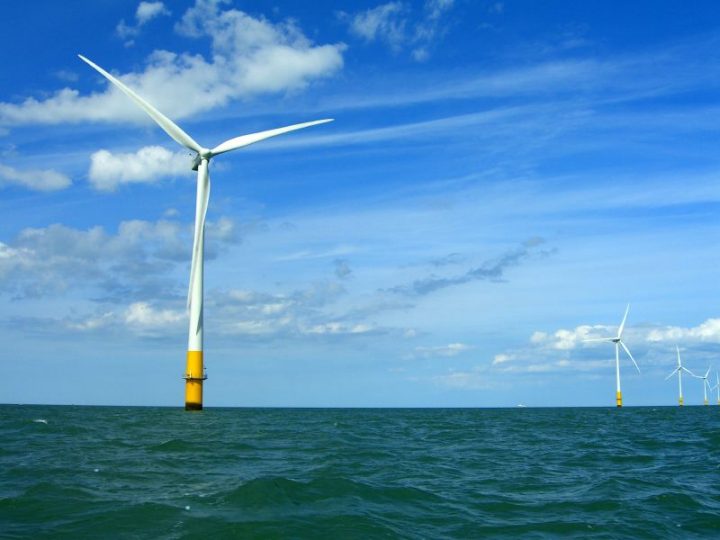In late May the Biden administration reached a decision to open two parts of the California coast to offshore wind energy: a 399-square-mile area off Morro Bay and another location off Humboldt County. Although breaking ground — or making waves in this case — may be a decade away, the Bureau of Ocean Energy Management (BOEM) has opened up the Humboldt and Morro Bay projects to public comment.

With steady wind and lots of space, the coasts promise to usher in the future of wind energy. Image credit: Phil Hollman via Wikimedia (CC BY 2.0)
At the global level, every effort to decarbonize is a boon for wildlife and the ecosystems they depend on. However, projects like wind farms and solar plants can impact their local environment. A commitment to sustainability involves looking at these concerns so they can be addressed in design and implementation.
Researchers at UC Santa Barbara with expertise ranging from energy systems and policy analysis to ornithology and marine life offer their take on how offshore wind capacity fits into the country’s energy portfolio, as well as the effect it may have on humans and wildlife.
Where the wind blows
Although offshore wind development has only just begun in the United States, it’s a promising source of energy for the country. It’s more efficient and reliable than land-based wind energy, and is often less variable than solar.
Wind blows more consistently over the ocean than it does over land, as there are few obstacles to get in its way. It also tends to vary less between day and night than wind over land. “Even if offshore wind is more expensive compared to onshore wind and solar, it is likely to add greater value to the electric grid, producing energy when demand is high,” explained Ranjit Deshmukh, an assistant professor in the UC Santa Barbara Environmental Studies Program whose research lies at the intersection of energy, environment and economics. That said, he added, the cost of offshore wind energy will likely drop as the U.S. builds and installs more turbines.
Variability is one of the largest hurdles to the expansion of renewable energy. Oftentimes solar and wind farms must curtail their activity during the day, as generation can exceed demand. On the other hand, these sources provide very little energy in California at night. And without the technology to store vast amounts of electricity, conventional power plants have to pick up this nighttime slack.
“Any resource that can generate in non-daylight hours, especially in the late evening, will face less curtailment,” Deshmukh said. And that is a huge step toward realizing a more reliable green energy grid.
“You also need a lot of land for wind power,” explained Assistant Professor Grace Wu, also in environmental studies. Her research has focused on developing land use planning tools to identify and understand the co-benefits and trade-offs between climate solutions, other human land uses, and habitat conservation.
Both Deshmukh and Wu have worked on renewable energy suitability in India and energy infrastructure in Southern Africa. They also have contributed to renewable energy siting in California and the Western U.S., and their user-friendly REZoning tool was recently released in partnership with the World Bank.
Unfortunately, suitable areas for land-based wind farms are increasingly difficult to find in California and neighboring states. “The state is seeking to build long transmission lines to out-of-state wind resources,” Deshmukh said, “which can take a long time and a lot of money.” These distances also increase the amount of energy lost in transit, he noted. Wind farms off the central coast would be relatively close to the region’s major population centers. And part of the reason the Morro Bay location was selected is the presence of existing onshore transmission infrastructure of decommissioned and soon-to-be retired power plants.
Placing turbines in the ocean also releases them from several constraints. The reason turbines are generally so tall is to place them in the path of unobstructed wind. But there aren’t any obstructions over the ocean, so these turbines don’t need the same height. Meanwhile, the size of land-based turbines is restricted by the logistics of transporting their enormous blades. But large blades can be carried out to sea without worrying as much about the size constraints due to roads, traffic and tight corners. And larger turbines are better turbines. Because the area of a circle scales with the square of its radius, a turbine with blades twice as long is far better than two standard turbines.
Building offshore turbines requires special ships to transport the massive components. The United States has only recently begun constructing such a ship, and is currently borrowing one from Europe for projects on the East Coast. That’s one reason government policy is so important: “If the industry doesn’t see a pipeline of new offshore wind power plants, they won’t invest in these ships because they’re so expensive to build,” Deshmukh said.
In this light, the expansion of offshore wind is a boon for the transition to renewable energy as a whole. Policy actions like these provide the assurance that industry needs to commit to developing the nation’s renewable energy capacity.
And as coastal oil production wanes, the skills of oil platform workers will translate well to work on offshore wind farms. While the need for renewable energy is clear, our transition away from fossil fuels must account for the people whose livelihoods are tied to these sectors. Their success is as much a matter of equity and climate justice as it is of political and economic pragmatism.
Feathered friends
Many critics of wind energy cite turbines’ heavy impact on birds, for instance. Indeed, 140,000 and 500,000 birds die from turbine strikes in the U.S. every year.
“Undoubtably there will be some birds killed,” agreed UC Santa Barbara ornithologist Stephen Rothstein. “But virtually everyone involved in ornithology and conservation biology feels that this number is just a fraction of the birds we’re going to lose if we don’t do something about climate change.”
Rothstein is a research professor in the Department of Ecology, Evolution, and Marine Biology, and a recipient of the American Ornithological Society’s prestigious Brewster Award for research conducted on birds of the Western Hemisphere.
While a lot of birds do hit wind turbines, the number barely registers when compared to other threats they face due to human activity in this country alone. Cars take out 300 to 400 million birds per year, while window strikes kill 500 million to 1 billion.
But our beloved cats pose perhaps the greatest threat to our feathered friends. Each year 1.4 to 3.7 billion birds fall to the feline claw in the U.S. The reason many bird species haven’t plummeted is mostly due to their incredible capacity to reproduce, Rothstein said. On the other hand, a great number have declined in recent decades as a result of habitat loss due to climate change and direct habitat destruction by people.
Although turbines are far from the biggest threat to birds, there are a number of strategies that can mitigate their impact. Placement can make a big difference. For example, birds often fly along specific pathways, Rothstein explained, so avoiding those locations when planning an onshore wind farm could save many birds.
There is a growing body of research on the effects wind installations have on seabirds, mostly confined to Europe, an early adopter of offshore wind farms. The literature generally deals with whether species are attracted to or avoid windfarms and the effect this has on resources such as food. Results suggest that more seem to avoid the farms, but Rothstein cautions against extrapolating too quickly to conditions in California. “The windfarms in California will be far off shore, whereas some of the European sites are much closer to shore and are situated on reefs and other shallow areas where seabirds feed the most,” he said.
In all, Rothstein is not overly worried about the negative impact offshore turbines will have on birds. “One thing that tells me this will actually help birds in the long run is that the National Audubon Society endorses wind turbines, with some proper precautions,” he said. Plus, dealing with climate change is essential for human welfare and all of biodiversity, he added.
Under the waves
The effect of the installations below the surface is perhaps even more nuanced. That said, there is some indication what might occur based on the interactions between marine life and other artificial structures in the ocean like buoys and oil platforms.
Unlike the East Coast or North Sea, the California coast is characterized by steep underwater topography. The areas identified by the U.S. Bureau of Ocean Energy Management (BOEM) are far offshore, and wind turbines will be floating structures anchored to deep, soft seabed well beyond the relatively narrow continental shelf.

Three possible designs for floating wind turbines. Image credit: Joshua Bauer, NREL
Much of what happens depends on how deep each turbine extends below the surface. “But there’s no question you’ll get a lot of animals living on it,” said Milton Love(link is external), a researcher at the university’s Marine Science Institute (MSI). “If you include little amphipods and things like that, you’re talking millions and millions of animals.”
“Deep sea animals that live in and on the mud will lose habitat impacted by the anchors,” added Mary Nishimoto(link is external), also a researcher at MSI. “But, in the upper part of the water column, where sunlight penetrates, the floating structure and anchor lines will provide surfaces for algae and invertebrates to attach.”
Love and Nishimoto, who’ve spent decades documenting the ecology of California’s oil platforms, explained that any submerged structure will essentially function as reef. Just as they do on oil platforms, encrusting invertebrates and algae will transform the underwater structure into a living habitat. Mussels, barnacles and the like will colonize the first 50 feet, followed by anemones, corals and sponges if the structure goes deeper.
The subsurface scaffolding of oil platforms provides habitat for fishes of all varieties, such as many species of rockfishes. If the underwater structure supporting the turbines provide substantial nursery grounds for fishes, like platforms do, then they could increase the regional abundance of certain species, Love said. However, since most of the nursery function occurs below 80 feet, he doubts this will be the case.

Artificial structures can provide very real habitat for millions of animals, from kelp bass to sea anemones. Image Credit: Ed Romero/UCSB
The distance offshore and bottom depth are major differences between California’s existing oil platforms and the proposed wind farms, Nishimoto added. “Platforms off California are within 10 miles of shore in waters 30 to 750 feet deep,” she said. “The proposed wind energy development areas will be more than 20 miles offshore where depths range from more than 1,000 to 4,000 feet.”
Flippers and flukes
The ocean is vast and often featureless, so anything afloat on the surface will attract fish, a fact well known to fishermen and scientists alike. And, much like buoys, if there’s a way to climb aboard the turbines, seals and sea lions will likely hop on for a haul-out.
One issue that could affect marine mammals, particularly whales, is the noise from the turbines. Operational noise could reverberate within the structure and propagate down the foundation into the surrounding water, explained Desray Reeb, a scientist at BOEM’s Pacific Region that has research connections with the Love Lab. However, for floating offshore wind, the foundation is replaced by mooring cables and reverberation is unlikely to be a major concern, but more research is needed to know for sure. “A lot of people think the ocean is a very quiet place, but it’s really not,” she said.
Entanglement is also a possible problem for whales, less so in the mooring cables themselves than in derelict fishing gear that might get snagged around them. This problem isn’t unique to floating turbine systems, but the extent of the wind farms will increase the chances of lost gear getting caught. A current BOEM study is working to assess this risk. “Future innovations might include sensors in the cables to detect if there are nets or gear entangled on the infrastructure and then trigger a mitigation response,” Reeb said.
The size of the installations means they could potentially interfere with marine mammal feeding and migration. And increased marine traffic will raise the possibilities of ship strikes. “Studies are ongoing as to where animals are, when they’re there and why they’re there,” said Reeb said. “This research will help validate models so we can develop the best mitigative strategies.”

Water traffic off the coast of California already poses a danger to whales, whose paths cross busy shipping lanes. Image credit: Olga Shpak via Wikimedia(CC BY-SA 3.0)
As for any effects from the power cables themselves: although data gaps remain, current thinking is that electromagnetic fields are a “non-issue” for marine mammals, according to Reeb.
Love doubts any of the other animals will notice, either. “We did a series of studies on the effects of electromagnetic fields in the Santa Barbara Channel,” he said. “The bottom line was that it does not seem to be an issue for fishes and invertebrates, at least based on our studies.”
As a whole, Love thinks the turbines are unlikely to have a drastic effect on the coastal ecosystem. “But no matter what anyone says they think is going to happen out there, no one will know until they are installed,” he added.
Fishermen
Offshore wind farms will certainly impact fishermen, but the nature and extent of those impacts depend largely on the specifics. There’s no question that the climate crisis has already begun to affect fish distribution and catch sizes, challenges to which fishermen will have to adapt. Increased renewable energy can mitigate these changes, but fishing communities worry about the closure of fishing grounds and other disruptions. The issue is not merely the large floating platforms, but the cables that carry electricity to shore and the increased water traffic involved in servicing these installations.
“We understand that climate change is real, and we definitely have to embrace renewable energy as a means to lowering carbon in the atmosphere,” said Chris Voss, president of the Commercial Fishermen of Santa Barbara. Voss is an alumnus and longtime collaborator with several researchers at UC Santa Barbara.
Depending on the density of the offshore installation, the turbines could effectively prevent commercial fishermen from operating in the locations without technically closing the areas outright. And although the wind farms will be over 20 miles from the coast, seafloor cables will carry the power to infrastructure onshore. You can’t troll, trawl or trap in areas where there’s a risk of snagging a cable, Voss explained, so the development will impact nearshore fisheries as well.
“And once the turbines and cables are there, there’s an immense amount of activity needed to support the offshore wind arrays,” he said. “It’s these kinds of concerns and impacts that need to be considered in advance.”
Ultimately, fishing communities want to be recognized as a significantly impacted industry during planning and implementation. Indeed, Voss explained, most fishing in the state is done in small operations.
“We understand significant change is going to be required to lower the amount of carbon that we emit into the atmosphere,” he said. “With that understanding, we would like the impacts to be mitigated when they affect the fishing community, which they will.”
Seafloor communication cables have already set a precedent for this sort of mitigation. When the cables impacted different fishing communities, the California State Lands Commission — which granted the permits to lay them — required companies to negotiate agreements with the communities.
“What we would like, from a policy perspective, is that kind of similar consideration moving forward,” Voss said. The important thing is to make an effort to mitigate any impacts during the conceptualization and planning phases.

Lobster fishermen prepare to set traps off the coast of Southern California. Image credit: Matt Kay/UCSB
For instance, decades ago oil companies and the fishing community established a traffic corridor approaching Ellwood pier to mitigate the effect of traffic to and from the oil platforms on fishing.
Factors that may seem incidental to one group of stakeholders can make a huge difference to another. “Seemingly small decisions can have a real big impact on how these things affect the fishing community,” Voss said. “It could involve very little additional cost; all it takes is a small amount of thought.”
The regulatory waters
Before California has any wind turbines off its coast, the projects will have to navigate through a dizzying array of government agencies, discussions and permitting processes. An endeavor like this will involve both federal and state agencies as well as private enterprises and local stakeholders.
The agreement announced in May is precisely that: a conceptual agreement between the state and federal governments to pursue offshore wind. It promises to streamline the decision process, which seems to mostly involve allocating the funds required to get the work done. “It’s not taking any of that work off the table; it’s just trying to make it happen more easily,” said Charles Lester, the director of UCSB’s Ocean and Coastal Policy Center and past executive director of the California Coastal Commission.
Any project will still require a lengthy environmental review as well as a review for consistency with state policy. “All these reviews will happen, and those reviews take time,” Lester said, adding that private industry will also have a lot of work to do before any construction begins.
A combination of different factors has held up offshore wind development in California. The first is the practical challenge of installing turbines in the deep water off the West Coast. Even once this became technically feasible, the endeavor still had to make economic sense, Lester explained.
The U.S. saw a similar progression with coastal oil exploration. Contrast extensive oil development in the shallow Gulf of Mexico with that in California, which has a much deeper coast and much stronger environmental movement.
Location was also a contentious issue, Lester explained. Many environmentalists wanted to keep wind farms out of marine sanctuaries, and the Monterey Bay National Marine Sanctuary spans much of the central coast. Meanwhile, the military wanted to keep structures out of nearly all of the Southern California region, where they conduct extensive exercises.
Now the technology has caught up with the challenges; wind energy has become economically attractive; and there is a growing demand for renewable energy. The military has come to an agreement on locations, and it seems logistics is the largest hurdle ahead.
Fortunately, the state had already begun discussing the possibility of offshore wind energy. In 2016 the federal Bureau of Ocean Energy Management (BOEM) established an intergovernmental renewable energy task force with other federal, state, local and tribal governmental stakeholders. “In part because of the history and experience we have with offshore oil, California supported the creation of the intergovernmental task force to look at offshore wind,” Lester said. The aim was to start coordinating all the different players early on.
“Of course, the context for wind energy is a lot different than for oil,” Lester added. “We’re talking about a global climate crisis. So, I think there’s a lot of motivation to try to deal with that overarching problem of CO2 emissions and getting off of fossil fuels.” That enthusiasm will prove helpful in pushing this endeavor through the legal processes to come.
The proposed sites lie in federal waters more than 20 miles offshore. But infrastructure like power cables and marine traffic will need to travel through state waters, giving California a measure of control.

The current extent of offshore wind proposals. Discussion is ongoing regarding whether the Diablo Canyon call area (south) will be included in future projects. Image credit: BOEM
BOEM is the lead federal agency for offshore wind development, but the state will retain influence under various state laws, as well as the U.S. Coastal Zone Management Act. Among other things, this legislation enables the state to review federal and federally permitted activities offshore — such as the leasing of federal waters for wind development — for consistency with California’s coastal management program. “The state will assert jurisdiction to review proposals, and that happens through the California Coastal Commission,” explained Lester, who worked at the Coastal Commission for nearly 19 years.
In addition to BOEM, federal involvement will include the military, Coast Guard and National Oceanic and Atmospheric Administration — which, aside from overseeing the Coastal Zone Management Act, also manages the country’s fisheries and marine life. Agencies like the California State Lands Commission, Energy Commission and Department of Fish and Wildlife will join the Coastal Commission on the state side.
“People in California have been talking with each other for a while now to try to zero in these areas where we’re going to pursue leasing and development,” Lester said. “Getting beyond that will still require a complicated governmental review process with lots of stakeholders involved.”
It’s hard to overstate the significance of this step. Research and policy work on conservation and management highlight time and again the importance of stakeholder involvement to the success of large projects like these. Between the effects offshore wind farms may have on fishermen, American Indians and coastal communities, their impacts on wildlife, and the way in which we incorporate them into our energy portfolio, there are many considerations to weigh before the project goes forward. Fortunately, the legal process enables us to account for these concerns.
“These are all issues that will have to be addressed before any project can move forward,” Lester said.
Source: UC Santa Barbara








